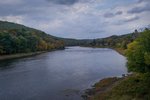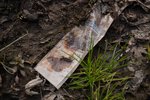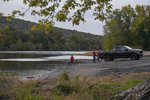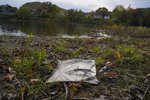 Narrowsburg
NarrowsburgLight Rain Fog/Mist, 43°
Wind: 8.1 mph
UPPER DELAWARE REGION — The Delaware River headwaters rise out of the ground in the Catskill Mountains and wind their way 330 miles between New York, Pennsylvania, New Jersey and Delaware to …
Stay informed about your community and support local independent journalism.
Subscribe to The River Reporter today. click here
This item is available in full to subscribers.
Please log in to continueNeed an account?
|







Delaware River facts:
Alliance for Watershed Education of the Delaware River, “Get to know this important waterway,” (water
shedalliance.org)
Delaware River—American Rivers (www.american
rivers.org/river/delaware-river/merican Rivers.org)
NY State Department of Environmental Conservation (dec.ny.gov)
On plastics:
Chesapeake Bay Program, “Small Plastics are a Big Problem,” (bit.ly/3Vpp2tn)
Alliance to End Plastic Waste, “The plastic waste problem explained,” (bit.ly/3CwasaN)
Philadelphia Inquirer, “Delaware River Basin Commission finds microplastics in river, tributaries,” (inquirer.com)
UPPER DELAWARE REGION — The Delaware River headwaters rise out of the ground in the Catskill Mountains and wind their way 330 miles between New York, Pennsylvania, New Jersey and Delaware to empty out into the Atlantic Ocean in the Delaware Bay.
Along its journey, the river is home to more than 60 species of fish, as well as the endangered American eel, and carries drinking water to animals including deer, beavers and over 13 million people. Nutrients and life flow from the Delaware River—Lenape Sipu as it is known to the area’s indigenous Lenape tribe—to countless beings, but it is also carrying something else: our trash, much of which is made of plastic.
In our modern era, it is nearly impossible to encounter a day without plastic. Perhaps your milk has come to you in a plastic jug, or your meat wrapped in a thin film of it; perhaps today you’ve put on synthetic leggings or a shirt, or touched the keys of your computer.
Plastic has become ubiquitous. The more we use it, the more there is to dispose of.
Many plastics can be recycled, assuming they find their way to the proper facilities. Some plastics, such as PET bottles or plastics made of HDPE (high density polyethylene), are “easier” to recycle, being melted into pellets that are then ready to be used for remolding. This is known as “mechanical process” recycling. Other plastics are “hard” to recycle (such as garbage bags and plastic film—those plastics with LDPE (low-density polyethylene). The “hard-to-recycle” plastics can be recycled with a chemical process—if they are recyclable at all.
Yet many plastics are not recycled, and wind up in the landfill or loose upon the land and waters, tossed from the window of a car, left behind at a campsite, or perhaps blown from a trash can or accidentally fallen from a backpack. Plastic accumulates on the sides of our roads, in the forest, and along the Delaware River banks and bridges.
“Every plastic that has ever been made is still on this planet in some form,” said Chanel Browne, Sea Turtle Program coordinator at the Maui Ocean Center Marine Institute in Hawaii.
Plastic can be repurposed or downcycled into other things, like a bag, rug or shoes, but it still remains, unable to be returned organically to the earth. There is also the culture of “wishcycling,” whereby people toss items in a recycling bin with the hope, “I think this is recyclable,” though in reality there may be little likelihood it will be recycled. About 4.2 million tons of plastic bags, sacks and wraps were created in the U.S. alone in 2018, according to the EPA’s data tables, and only 10 percent of those were recycled.
Though plastics are a relatively new invention, gaining popularity only 60 to 70 years ago, the World Wildlife Fund estimates that it will take 450 years for a plastic water bottle or plastic cup to break down. Thus, all the plastics created so far are still circulating in some form.
Meanwhile, the plastics that wind up in our watersheds are found by animals that live there. Plastics wash into the water through storm drains, or even as tiny pieces breaking off from clothing in washing machines and flowing out through pipes. Larger pieces of plastic, such as fishing line and netting, can cause wildlife entanglement. Animals also ingest pieces of plastic.
“The largest issue regarding sea turtles and plastic ingestion is the possibility that hard plastics may rupture internal organs,” said Browne. “Ingestion of foreign items may also cause a blockage of gas within a sea turtle’s body cavity, which could lead to buoyancy issues.”
A buoyant turtle is unable to dive and feed on the ocean floor, which could inevitably lead to its death from overheating or starvation.
60 percent of seabirds have also consumed some form of plastic, and that number is estimated to increase to 99 percent by 2050.
Large or whole plastics are tumbled by the elements, breaking down into smaller and smaller pieces, known as “microplastics.” A microplastic is a plastic piece that measures under five millimeters in size. These are also consumed by animals, and the impact of microplastic multiplies as it works its way up the food chain; a small fish is consumed by a larger fish, and then a larger one, which is then harvested by humans.
Microplastics are “sticky,” and not only leach out the chemicals they were made with, but also absorb chemicals in the water as well. These chemicals, linked to cancer and birth defects, have been detected in fish such as wild sea bass, which are in turn eaten by people.
Along the Delaware River, microplastics were found at all 15 sites that were tested in the past several years by the Delaware River Basin Commision. Many of these microplastics were fibers, such as from polyester or rayon.
To get ahead of the increasing plastics in our world, we need to take proactive steps to reduce unnecessary use of them. Being aware that things we throw away don’t so easily “go away” is a start. Think about where in your daily schedule you opt for convenience over the earth’s health—for example, getting a plastic cup of your drink at your favorite coffee shop, rather than bringing a cup you can refill over and over again. (For more on restaurant waste in general, see “Restaurants can curb our appetite for plastic,” page 14.)
Likewise with shopping bags; on March 1, 2020, New York State passed the Bag Waste Reduction Law, banning plastic carry-out bags from all stores that collect New York sales tax. Though there are paper bags for five cents each, every consumer also has the option to bring a reusable bag that can be used again and again, lessening the impact of both plastic and paper.
Across the river border in Pennsylvania, plastic bags are still readily available at stores, though consumers can also, of course, choose to bring their own bag. It is just the matter of that choosing, or intention.
It is essential to not skip the first step in the mantra “Reduce, Reuse, Recycle.” While many take comfort they are serving the future of the earth with that last step, “recycle,” the first step reduces the amount of bags or cups that need to be manufactured in the first place by decreasing the demand for them, and thereby preserving the natural resources, such as trees or petroleum, that would have been used in their production.
We can also ensure that recyclable plastics actually make their way into recycling, and pick up plastics we see along waterways.
Our actions can cause change, and that change can only multiply its effect when sustainable measures are adopted by states, companies and corporations, which naturally have a larger footprint in consumption and dissemination of materials.
The waters of our planet are connected. Rain washes into rivers, rivers flow to the sea, and worldwide ocean currents circulate that water, including any plastic that has flowed into it. Consciousness about plastic usage, both on the individual level and that of the community, can ebb its flow and create a Delaware River and wider ocean habitat that will support healthy living for all.
Related stories

Comments
No comments on this item Please log in to comment by clicking here